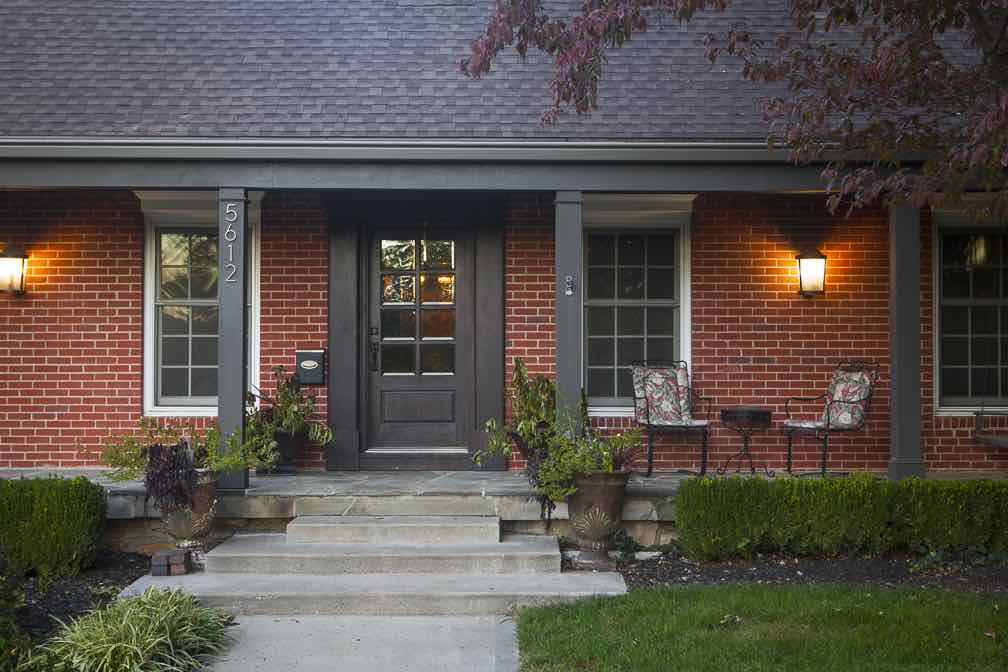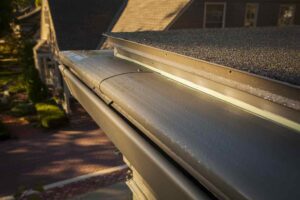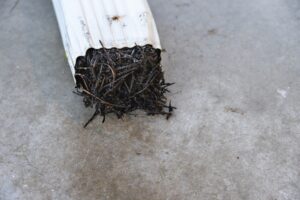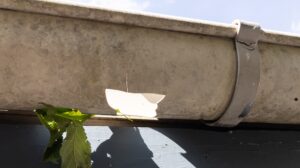1. Inspect the Front of Your Gutters
Start by standing underneath your gutters and taking four big steps away from your house into the yard. Turn around and look at the front face of your gutter, identifying where the downspout is located. The downspout should be the lowest point along the gutter, with the end farthest from the downspout being the highest. Ensure that your gutter is making a nice, gradual downward slope from the highest point to the downspout. If you have downspouts at both ends of the gutter, the highest point should be in the middle, creating a slight “frown” as it slopes down in both directions.
If the slope of the gutter is hard to determine, look at the bottom of the fascia wood mounted behind the gutter. Notice the distance from the bottom of the gutter to the bottom of the fascia wood, typically around 2 to 3 inches. Compare the thickness at the end farthest from the downspout to the thickness near the downspout. If your gutters are pitched correctly, you should see that the distance is less as you approach the downspout.
If the distance is not decreasing, or if the bottom of your gutter waves up and down, your gutters may be back-pitched. Back-pitching indicates that the gutters need to be re-adjusted or, in most cases, replaced, as metal that starts to bend and sag loses its structural integrity. In Colorado, this naturally starts to occur after 10 to 15 winters of heavy ice buildup inside the gutter. That’s why it’s essential to use the thickest aluminum available with the strongest brackets. K-Guard Rocky Mountains only uses 0.032” thickness aluminum—the thickest aluminum that can be bent into the shape of a gutter without cracking the polymer-coated paint. K-Guard’s patented internal brackets can support 75 pounds each and are placed every two feet. Along with K-Guard’s patented reverse curve technology hood, K-Guard gutters can’t lose their pitch over time. If they do, K-Guard will repair or replace your gutters at no charge, as part of the double-lifetime, transferable “No Pull Away Warranty.”
When gutters become back-pitched, they act as if they’re clogged, as water cannot flow uphill to the downspout. The water pools at the low points and overflows, damaging your home’s foundation and exterior. Back-pitching can lead to thousands of dollars in damage if not addressed, making it the first thing you should check when inspecting your gutters.
2. Look Down the Front Face of Your Gutter
Walk to the end of your gutter and look straight down the front face from the end cap. Do you notice any bowing, waving, or warping of your gutters? Your gutters should be in a straight line; if not, they are close to needing replacement. Bowing, waving, and warping result from ice expansion inside the gutter (or from external pressure, such as someone hanging from them). Ice expansion occurs when ice forms inside the gutter, expanding and cracking as it freezes and thaws, just like an ice cube dropped into a glass of water.
This expansion puts pressure on the structural integrity of your gutters, warping the aluminum and slowly pulling the screws that mount the gutter brackets out of the wood. Eventually, the weight of ice, snow, and rainwater causes the gutter to back-pitch, compromising its structural stability. This is one of the most common causes of gutter failure in Colorado, besides clogging. To combat ice expansion, it’s crucial to use the thickest aluminum possible with the strongest brackets. K-Guard gutters, combined with K-Guard’s reverse curve technology hood, prevent ice buildup inside the gutter trough.
3. Check the Bottom of Your Gutter
Examine the bottom of your gutter for any holes, daylight, or rust spots where water can escape and drip straight into your foundation. When gutters back-pitch or form bellies due to loss of structural integrity, water pools at the bottom and accelerates the oxidation process, leading to rust over time. K-Guard gutters are designed to never belly or back-pitch, and their aluminum has a polymer coating that prevents rusting over time. Also, look at the wood behind and underneath your gutter for signs of water damage.
4. Inspect Your Downspouts
Are your downspouts showing any signs of rust? What size are they? If your downspouts are 2 inches by 3 inches, consider replacing them with the newer 3-inch by 4-inch downspouts. The larger downspout is designed to flush water out of your gutter more efficiently, similar to how a toilet drain functions compared to a bathroom sink drain.
Look at the seam on the backside of your downspout—has it split open due to ice expansion? If so, water is escaping onto the side of your house, causing exterior damage. The seams on smaller downspouts are notorious for splitting open because they are only crimped once. This is more common with downspouts connected to underground drains, where water can freeze below ground and back up into the downspout. K-Guard uses larger downspouts with thicker aluminum, crimped twice at the back seam, ensuring they won’t split open.
Finally, check where the water is evacuating at the bottom of the downspout. If it’s not flowing into an underground drain, the United States Geological Survey recommends that rainwater be evacuated at least three feet from the foundation. How far is your downspout opening from your home?
5. Look for Loose Screws, Spikes, or Brackets
As your gutters lose structural integrity over time, they may shed some of their supportive hardware, which can end up on the ground or be flushed out through the downspout. If you see any of this hardware lying around near your gutters, it could be a sign that something is wrong.
6. Inspect the Inside of Your Gutter for Missing Brackets or Clogs
Getting on a ladder to inspect the inside of your gutters can be risky. At K-Guard Rocky Mountains, we do not recommend this. Our goal is to keep people off ladders permanently. Our representatives conduct a free inspection using a camera pole to check what’s going on inside your gutters. We share these pictures with you, along with our professional recommendations, so you can make an informed decision about what to do next—pressure and hassle-free.
Contact K-Guard Rocky Mountains
Are you still unsure if your gutters are working correctly? Have you found obvious damage through your inspection?
Contact K-Guard Rocky Mountains for a free inspection and consultation on a solution that’s right for your home and budget.




